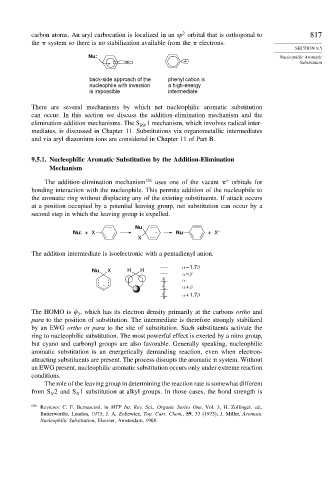Page 834 - Advanced Organic Chemistry Part A - Structure and Mechanisms, 5th ed (2007) - Carey _ Sundberg
P. 834
2
carbon atoms. An aryl carbocation is localized in an sp orbital that is orthogonal to 817
the system so there is no stabilization available from the electrons.
SECTION 9.5
Nu: Nucleophilic Aromatic
X + Substitution
back-side approach of the phenyl cation is
nucleophile with inversion a high-energy
is impossible intermediate
There are several mechanisms by which net nucleophilic aromatic substitution
can occur. In this section we discuss the addition-elimination mechanism and the
elimination-addition mechanisms. The S RN 1 mechanism, which involves radical inter-
mediates, is discussed in Chapter 11. Substitutions via organometallic intermediates
and via aryl diazonium ions are considered in Chapter 11 of Part B.
9.5.1. Nucleophilic Aromatic Substitution by the Addition-Elimination
Mechanism
∗
The addition-elimination mechanism 126 uses one of the vacant orbitals for
bonding interaction with the nucleophile. This permits addition of the nucleophile to
the aromatic ring without displacing any of the existing substituents. If attack occurs
at a position occupied by a potential leaving group, net substitution can occur by a
second step in which the leaving group is expelled.
Nu
Nu: + X – Nu + X –
X
The addition intermediate is isoelectronic with a pentadienyl anion.
α – 1.7β
Nu X H H
α – β
α
- α + β
α + 1.7β
The HOMO is , which has its electron density primarily at the carbons ortho and
3
para to the position of substitution. The intermediate is therefore strongly stabilized
by an EWG ortho or para to the site of substitution. Such substituents activate the
ring to nucleophilic substitution. The most powerful effect is exerted by a nitro group,
but cyano and carbonyl groups are also favorable. Generally speaking, nucleophilic
aromatic substitution is an energetically demanding reaction, even when electron-
attracting substituents are present. The process disrupts the aromatic system. Without
an EWG present, nucleophilic aromatic substitution occurs only under extreme reaction
conditions.
The role of the leaving group in determining the reaction rate is somewhat different
from S 2 and S 1 substitution at alkyl groups. In those cases, the bond strength is
N N
126
Reviews: C. F. Bernasconi, in MTP Int. Rev. Sci., Organic Series One, Vol. 3, H. Zollinger, ed.,
Butterworths, London, 1973; J. A. Zoltewicz, Top. Curr. Chem., 59, 33 (1975); J. Miller, Aromatic
Nucleophilic Substitution, Elsevier, Amsterdam, 1968.

